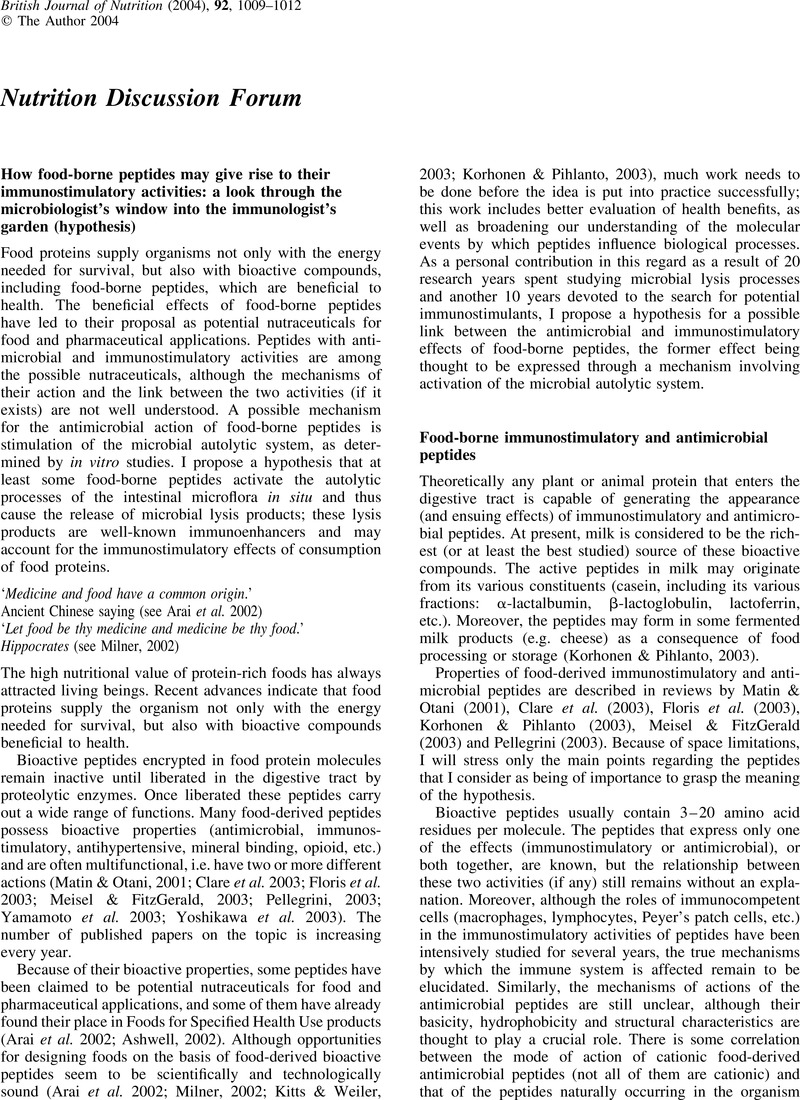Crossref Citations
This article has been cited by the following publications. This list is generated based on data provided by Crossref.
Sederevičius, Antanas
Ramanauskienė, Jurgita
Lukauskas, Kazimieras
Kazlauskaitė, Jurgita
and
Biziulevičius, Gediminas A.
2005.
An enzymatic cow immunity-targeted approach to reducing milk somatic cell count: 2. A study using lysozyme.
Food and Agricultural Immunology,
Vol. 16,
Issue. 3,
p.
193.
Kazlauskaitė, Jurgita
Biziulevičius, Gediminas A.
Žukaitė, Vilhelmina
Biziulevičienė, Genė
Miliukienė, Valė
and
Šiaurys, Almantas
2005.
Oral tryptic casein hydrolysate enhances phagocytosis by mouse peritoneal and blood phagocytic cells but fails to prevent induced inflammation.
International Immunopharmacology,
Vol. 5,
Issue. 13-14,
p.
1936.
Sederevičius, Antanas
Balsytė, Jolita
Lukauskas, Kazimieras
Kazlauskaitė, Jurgita
and
Biziulevičius, Gediminas A.
2006.
An enzymatic cow immunity-targeted approach to reducing milk somatic cell count: 3. A comparative field trial.
Food and Agricultural Immunology,
Vol. 17,
Issue. 1,
p.
1.
Biziulevičius, Gediminas A.
2006.
Where do the immunostimulatory effects of oral proteolytic enzymes (‘systemic enzyme therapy’) come from? Microbial proteolysis as a possible starting point.
Medical Hypotheses,
Vol. 67,
Issue. 6,
p.
1386.
Biziulevičius, Gediminas A.
and
Kazlauskaitė, Jurgita
2007.
Following Hippocrates’ advice ‘Let food be thy medicine and medicine be thy food’: An alternative method for evaluation of the immunostimulatory potential of food proteins.
Medical Hypotheses,
Vol. 68,
Issue. 3,
p.
712.
Morris, Humberto J.
Carrillo, Olimpia V.
Alonso, María E.
Bermúdez, Rosa C.
Almarales, Ángel
Llauradó, Gabriel
Lebeque, Yamila
and
Fontaine, Roberto
2011.
Oral Administration of an Enzymatic Protein Hydrolysate from the Green MicroalgaChlorella vulgarisEnhances the Nutritional Recovery of Malnourished Mice.
Journal of Medicinal Food,
Vol. 14,
Issue. 12,
p.
1583.
Agyei, Dominic
and
Danquah, Michael K.
2012.
Rethinking food-derived bioactive peptides for antimicrobial and immunomodulatory activities.
Trends in Food Science & Technology,
Vol. 23,
Issue. 2,
p.
62.
Oseguera-Toledo, M.
Dia, V. P.
de Mejia, E. Gonzalez
and
Amaya Llano, S. L.
2012.
Hispanic Foods: Chemistry and Bioactive Compounds.
Vol. 1109,
Issue. ,
p.
217.
Jaafar, R M
Kania, P W
Larsen, A H
Nielsen, D S
Fouz, B
Browdy, C
and
Buchmann, K
2013.
Gut microbiota changes in rainbow trout, Oncorhynchus mykiss (Walbaum), during organic acid feed supplementation and Yersinia ruckeri infection.
Journal of Fish Diseases,
Vol. 36,
Issue. 6,
p.
599.
Pozzolini, Marina
Scarfì, Sonia
and
Giovine, Marco
2020.
Encyclopedia of Marine Biotechnology.
p.
1007.



